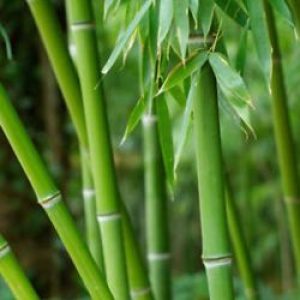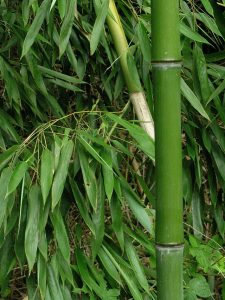In this respect, there are two types of bamboo: rampant and non-rampose. Sometimes half a forest has grown from one underground root (rhizome). In nature, this is very nice for beautiful forests. This first plant still has to fight hard for its place in the ground. The bamboo that emerges from these underground roots, on the other hand, already has a nice network to meet its needs for successful growth. So you can plant a small bamboo plant that, a few years later, will produce huge new plants. In this way, huge shoots emerge from the ground and give you super strong bamboo to harvest. With non-growing, or: clumping bamboo, it is actually one bamboo that is the mother. From the underground clump of that one bamboo, other plants grow. In the wild, you can recognise these as clusters of bamboo together.



The way it grows determines to a large extent how thick the bamboo is. Unlike a tree, bamboo does not grow wider above ground as it ages. But the bamboo does not emerge from the ground as an adult tree. As you can see in the photo, despite their size, they are really shoots. Eventually they grow to a height of 30 metres! Bamboo always has a slight ‘taper’. This means that there is a margin difference in the ø (diameter). So it does matter on which side you measure it. You will hardly notice the difference with posts up to 2 metres long. With poles longer than 3 metres, however, you can put a percentage on it. Guadua, for example, has a much firmer diameter and averages about 10%. With Moso bamboo, this can be about 20-30%. But that does not necessarily mean that there is a difference in diameter in your stick. It is not always the case that there is such a difference. This has to do with the position of the stick in the entire bamboo.
For example, a Moso bamboo can grow up to 28 metres high! If you take out 3-metre stakes, some of the stakes will be at the top and some at the foot of the bamboo. The degree of change is determined by which part of the plant the pole comes from. Of course, we always make sure that these margins are as small as possible.
Apart from the degree of tapering, the distance between the nodes also says something about which part the pole comes from. For example, at the bottom of the bamboo, many nodes are relatively close together. As the bamboo grows, the space between the nodes will also grow. At the top, the space between the nodes decreases. The nodes give the bamboo strength and determine the strength of the bamboo. So it is efficient for the bamboo to have less space between nodes at the bottom. The space between the nodes is partly determined by the species. One species has more space than another. The conditions also play an important role. More water means larger internodes.
![]()
